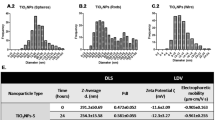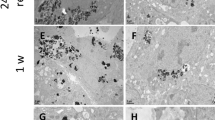Abstract
The increasing use of nanomaterials in healthcare and industrial products heightens the possibility of their ingestion by humans, other mammals, and fish. While toxicity of many nanomaterials has recently been studied, reports of non-lethal effects of nanomaterials remain ill-defined. This study investigates possible pathways by which nanoparticles, titanium dioxide (TiO2), could cross the epithelium layer by employing both toxicity and mechanistic studies. This study provides evidence that at 10 μg/mL and above, TiO2 nanoparticles cross the epithelial lining of the intestinal model by transcytosis, albeit at low levels. TiO2 was able to penetrate into and through the cells without disrupting junctional complexes, as measured by γ-catenin. To monitor the epithelial integrity, transepithelial electrical resistance (TEER) was employed and determined low concentrations (10 or 100 μg/mL) of TiO2 do not disrupt epithelial integrity. Live/dead analysis results did not show cell death after exposure to TiO2. In addition, at 10 μg/mL (and above) TiO2 nanoparticles begin alteration of both microvillar organization on the apical surface of the epithelium as well as induce a rise in intracellular-free calcium. The latter is a mechanism cells use to respond to extracellular stimuli and may be linked to the alteration of the apical microvilli. Although TiO2 does not show cell death, the implication of other, non-lethal, effects could lead to undesired outcomes (i.e., disease, malnutrition, shortened life span, etc.).








Similar content being viewed by others
Abbreviations
- TiO2 :
-
titanium dioxide
- TEER:
-
transepithelial electrical resistance
References
Allen NS, Edge M, Sandoval G, Verran J, Stratton J, Maltby J. Photocatalytic coatings for environmental applications. Photochem Photobiol . 2005;81:279–90.
Berridge MJ, Bootman MD, Roderick HL. Calcium signalling: dynamics, homeostasis and remodelling. Nat Rev Mol Cell Biol. 2003;4:517–29.
Bretscher A, Weber K. Villin is a major protein of the microvillus cytoskeleton which binds both G and F actin in a calcium-dependent manner. Cell. 1980;20:839–47.
Capco DG, McGaughey RW. Cytoskeletal reorganization during early mammalian development: analysis using embedment-free sections. Dev Biol. 1986;115:446–58.
Esterkin CR, Negro AC, Alfano OM, Cassano AE. Air pollution remediation in a fixed bed photocatalytic reactor coated with TiO2. Aiche Journal. 2005;51:2298–310.
Fisher J, Egerton T. Titanium compounds, inorganic. Kirk-Othmer encyclopedia of chemical technology. New York: Wiley; 2001.
Hiemenz PC. Principles of colloid and surface chemistry. New York: Marcel Dekker; 1997.
Higarashi MM, Jardim WE. Remediation of pesticide contaminated soil using TiO2 mediated by solar light. Catalysis Today. 2002;76:201–7.
Jani PU, Mccarthy DE, Florence AT. Titanium-dioxide (rutile) particle uptake from the rat GI tract and translocation to systemic organs after oral-administration. Int J Pharm. 1994;105:157–68.
Kaida T, Kobayashi K, Adachi M, Suzuki F. Optical characteristics of titanium oxide interference film and the film laminated with oxides and their applications for cosmetics. J Cosmet Sci. 2004;55:219–20.
Koeneman, B.A. and Capco, D.G. (2004). Cellular interactions. Encyclopedia of Molecular Cell Biology and Molecular Medicine. R. Meyers. Weinheim, Wiley-VCH. 2: 463-486.
Koeneman BA, Lee KK, Singh A, He J, Raupp GB, Panitch A, et al. An ex vivo method for evaluating the biocompatibility of neural electrodes in rat brain slice cultures. J Neurosci Methods. 2004;137:257–63.
Koeneman BA, Zhang Y, Hristovski K, Westerhoff P, Chen Y, Crittenden JC, et al. Experimental approach for an in vitro toxicity assay with non-aggregated quantum dots. Toxicol In Vitro. 2009;23:955–62.
Kong J, Franklin NR, Zhou CW, Chapline MG, Peng S, Cho KJ, et al. Nanotube molecular wires as chemical sensors. Science. 2000;287:622–5.
Konstantinou IK, Albanis TA. TiO2-assisted photocatalytic degradation of azo dyes in aqueous solution: kinetic and mechanistic investigations—a review. Appl Catal, B Environ. 2004;49:1–14.
Lomer MC, Kodjabashia K, Hutchinson C, Greenfield SM, Thompson RP, Powell JJ. Intake of dietary iron is low in patients with Crohn's disease: a case-control study. Br J Nutr. 2004;91:141–8.
Long RQ, Yang RT. Carbon nanotubes as superior sorbent for dioxin removal. J Am Chem Soc. 2001;123:2058–9.
Lux R. The nanotech report. 5th ed. New York, NY: Lux; 2007.
Martin CR, Kohli P. The emerging field of nanotube biotechnology. Nature Reviews Drug Discovery. 2003;2:29–37.
Mooseker MS. Brush border motility. Microvillar contraction in triton-treated brush borders isolated from intestinal epithelium. J Cell Biol. 1976;71:417–33.
Oberdörster G, et al. Principles for characterizing the potential human health effects from exposure to nanomaterials: elements of a screening strategy. Part Fibre Toxicol. 2005;2:8.
Peterson MD, Mooseker MS. Characterization of the enterocyte-like brush border cytoskeleton of the C2BBe clones of the human intestinal cell line, Caco-2. J Cell Sci. 1992;102(Pt 3):581–600.
Peterson MD, Mooseker MS. An in vitro model for the analysis of intestinal brush border assembly. I. Ultrastructural analysis of cell contact-induced brush border assembly in Caco-2BBe cells. J Cell Sci. 1993;105(Pt 2):445–60.
Peterson MD, Bement WM, Mooseker MS. An in vitro model for the analysis of intestinal brush border assembly. II. Changes in expression and localization of brush border proteins during cell contact-induced brush border assembly in Caco-2BBe cells. J Cell Sci. 1993;105(Pt 2):461–72.
Stevens CE, Hume ID. Contributions of microbes in vertebrate gastrointestinal tract to production and conservation of nutrients. Physiol Rev. 1998;78:393–427.
Swanson JA, Lee M, Knapp PE. Cellular dimensions affecting the nucleocytoplasmic volume ratio. J Cell Biol. 1991;115:941–8.
Thess A, et al. Crystalline ropes of metallic carbon nanotubes. Science. 1996;273:483–7.
Williams ED, Ayres RU, Heller M. The 1.7 kilogram microchip: energy and material use in the production of semiconductor devices. Environ Sci Technol. 2002;36:5504–10.
Wolf R, Matz H, Orion E, Lipozencic J. Sunscreens—the ultimate cosmetic. Acta Dermatovenerol Croat. 2003;11:158–62.
Zhang Y, Chen Y, Westerhoff P, Hristovski K, Crittenden JC. Stability of commercial metal oxide nanoparticles in water. Water Res. 2008;42:2204–12.
Zhang X, Sun H, Zhang Z, Niu Q, Chen Y, Crittenden JC. Enhanced bioaccumulation of cadmium in carp in the presence of titanium dioxide nanoparticles. Chemosphere. 2007;67:160–6.
Acknowledgments
The authors are grateful for funding from the U.S. Environmental Protection Agency. The authors thank the W.M. Keck Bioimaging Laboratory and the Electron Microscope Laboratory in the School of Life Sciences Bioimaging Facility at Arizona State University managed by Bret Judson and David Lowry, respectively.
Although the research described in this article has been funded wholly or in part by the United States Environmental Protection Agency through grant/cooperative agreement RD831713 to Arizona State University, it has not been subjected to the Agency's required peer and policy review and therefore does not necessarily reflect the views of the Agency and no official endorsement should be inferred.
Author information
Authors and Affiliations
Corresponding author
Rights and permissions
About this article
Cite this article
Koeneman, B.A., Zhang, Y., Westerhoff, P. et al. Toxicity and cellular responses of intestinal cells exposed to titanium dioxide. Cell Biol Toxicol 26, 225–238 (2010). https://doi.org/10.1007/s10565-009-9132-z
Received:
Accepted:
Published:
Issue Date:
DOI: https://doi.org/10.1007/s10565-009-9132-z




